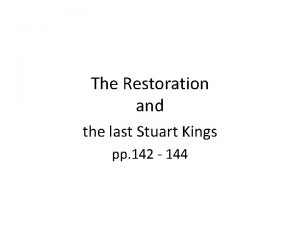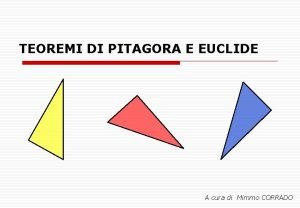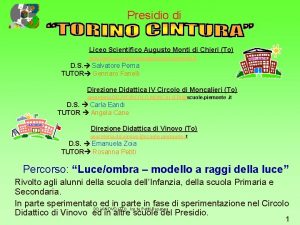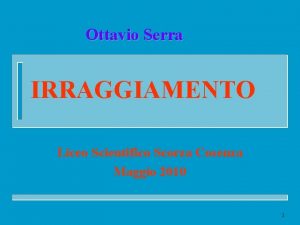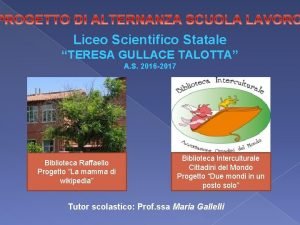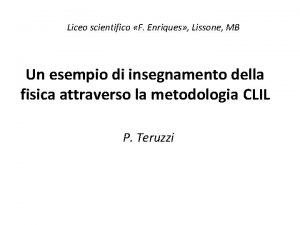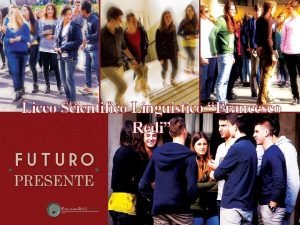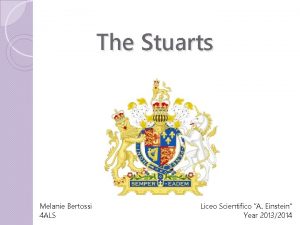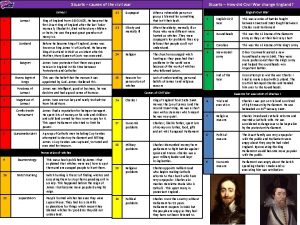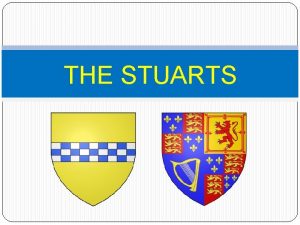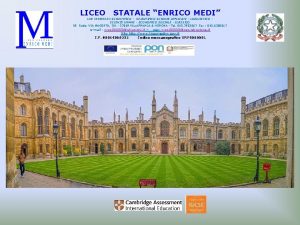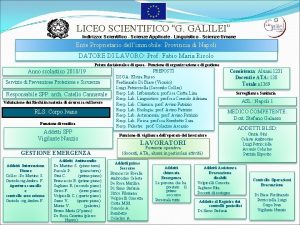The Stuarts in English history Liceo Scientifico A














- Slides: 14

The Stuarts in English history Liceo Scientifico “A. Einstein” School Year 2013 – 2014 Class 4 ALS Student: Vitale Elisa

The Stuarts • Royal house that ruled Scotland. • Ruled England from 1603 to 1714 after the House of Tudor. • Succeded by the House of Hanover. • Originally “House of Stewart”: Stewart comes from “steward” (political position of office similar to a governor). • Origins date back to Norman Conquest when Alan Fitz. Flaad came to Scotland. His great-grandson became first hereditary High Steward of Scotland. • XVI century: Mary, Queen of Scots adopted the French spelling “Stuart”. 2

The Stuarts in England (1603 – 1714) Early Stuarts • 1603 – 1625: King James VI and I • 1625 – 1649: King Charles I Late Stuarts • 1660 – 1685: King Charles II • 1685 – 1688: King James II • 1689 – 1694: Queen Mary II • 1689 – 1702: King William III • 1702 – 1714: Queen Anne 3

James VI and I of Scotland (born 1566 – died 1625) • Son of Mary, Queen of Scots. • 1567: Became King of Scotland at 1 year old. • 1603: Succeeded Elizabeth I Tudor and became King of England and Scotland united under one monarch. • 1609: Ulster Plantation introduced English and Irish Protestants into Northern Ireland. • Believed in Divine Right of Kings. • Made Sunday Church-going compulsory. • Refused to listen to Puritan demands for Church reform. 4

James VI and I of Scotland (born 1566 – died 1625) • Unable to treat with the Parliament • Unable to solve the country’s financial, political and religious problems: left the country badly in debt. • Cultural flourishing continued from Elizabethan Era: supported an English translation of the Bible. • James I wasn’t a good king, had bad habits (avoided hard work, never washed his hands, …) and was distant from his people. 5

Charles I of England (born 1600 – died 1649) • James I’s second son (his brother died in 1612) • 1625: Became King of England • Opposed the Parliament and believed in Divine Right of Kings. • Supported the Church and married the catholic Henrietta Maria. • 1629: Needed money to fight against Spain and France. The Parliament refused his requests. Charles dismissed Parliament and ruled alone for 11 years Petition of Right • 1639 – 1640: Bishops Wars • 1642 – 1651: Civil War • Executed in 1649. 6

Petition of Right (1628) • Presented by Sir Edward Coke because Charles I broke up Parliament and ruled on his own. • Cited the Magna Carta (1215): the King isn’t above the law and can’t give Englishmen their rights. • Charles I was asked: – Not to impose taxes without the Parliament’s approval; – Not to imprison free men without trials; – Not to force free men to billet soldiers and sailors. • The king accepted the Petition of Right, but soon broke his word and resumed the violations. This struggle resulted in the Civil War and ended with the beheading of Charles I in 1649. 7

Interregnum: Oliver Cromwell (born 1599 – died 1658) • Parliament member. • Signatory of King Charles I's death warrant. • 1649: Became Lord Protector of the republic of England, also known as Commonwealth. • Refused the crown and ruled without Parliament. • Religious toleration including Jews, excluding Atheists and Catholics. • Defeated supporters of the king’s son Charles II. • Succeeded by son Richard in 1658, who had no wish to rule and ran away from London in 1660. 8

Charles II of England (born 1630 – died 1685) • • Charles I’s son. 1649: became King of England, and was recognised as King of Scotland Ireland. 1649 – 1660: Interregnum and Commonwealth. 1660: Parliament invited him to come back as King of England (Restoration). Known as “Merry Monarch” because of his love for parties, music and theatre: abolished Cromwell’s laws that forbade music and dancing. Approved the foundation of Royal Society. Extravagant with money debts. Forced to marry Portuguese Catherine of Braganza from whom he had no children. 9

James II of England (born 1633 – died 1701) • Charles II’s brother. • 1685: Became King of England despite Parliament opposition and Test Acts (1673). • Religious policy, openly catholic. • Wanted his son James Francis Edward to succeed him. Excluded his nephew William III of Orange and his daughter Mary Bill of rights. • 1688: Glorious Revolution and end of James II’s reign. • 1689: James II was exiled in France. 10

Bill of Rights (1689) Act presented by William of Orange and Mary, inviting them to become sovereigns of England. • Condemned James II of England. • Set right of the Parliament and limited the power of the crown: end of the Divine Right of Kings • Established that the King always had to be Protestant. • Reestablished the liberty of Protestants to have arms for their defence within the rule of law. • Required regular elections to Parliament. • Established the right to petition the monarch without fear of retribution. 11

Mary II of England (born 1662 – died 1694) • James II’s daughter, William III’s cousin and wife. • Protestant. • 1689: Became Queen of England Ireland. • Shared the throne with her husband, but had less power than him. • William heavily relied on her. • Ruled alone during William’s military campaigns, proving herself to be a powerful, firm, and effective ruler. • Died in 1694, leaving the throne to William. 12

William III of England (born 1650 – died 1702) • James II’s nephew, Mary II’s cousin and husband. • Last of the House of Orange. • Protestant. • 1689: Became King of England, Scotland Ireland. • Known as “King Billy”. • Transition from personal to Parliamentcentred rule. • 1697: Defeated Louis XIV of France, his lifelong enemy. • Died in 1702 after an incident (broken collarbone). He had no heir. 13

Anne, Queen of Great Britain (born 1665 – died 1714) • • • Mary II’s sister. Married to Prince George of Denmark. First Queen of Great Britain. 1707: Act of Union. Kingdoms of England Scotland became the United Kingdom of Great Britain. Known as “brandy nan”. Protestant. Supported the Glorious Revolution. Last of the Stuart dinasty: none of her children survived infancy. Succeeded by George I of Hanover in 1714. 14
 The restoration and the last stuarts
The restoration and the last stuarts Euclide teorema
Euclide teorema Liceo scientifico monti chieri
Liceo scientifico monti chieri Liceo scorza
Liceo scorza Liceo galileo galilei piedimonte matese
Liceo galileo galilei piedimonte matese Liceo scientifico gullace
Liceo scientifico gullace Liceo scientifico dolo
Liceo scientifico dolo Liceo scientifico antonio gallotta
Liceo scientifico antonio gallotta Liceo scientifico leon battista alberti minturno
Liceo scientifico leon battista alberti minturno Scuola marconi foggia
Scuola marconi foggia Liceo enriques lissone
Liceo enriques lissone Liceo scientifico roccapiemonte
Liceo scientifico roccapiemonte Galilei dolo
Galilei dolo Liceo fracastoro
Liceo fracastoro Po pv pl
Po pv pl
